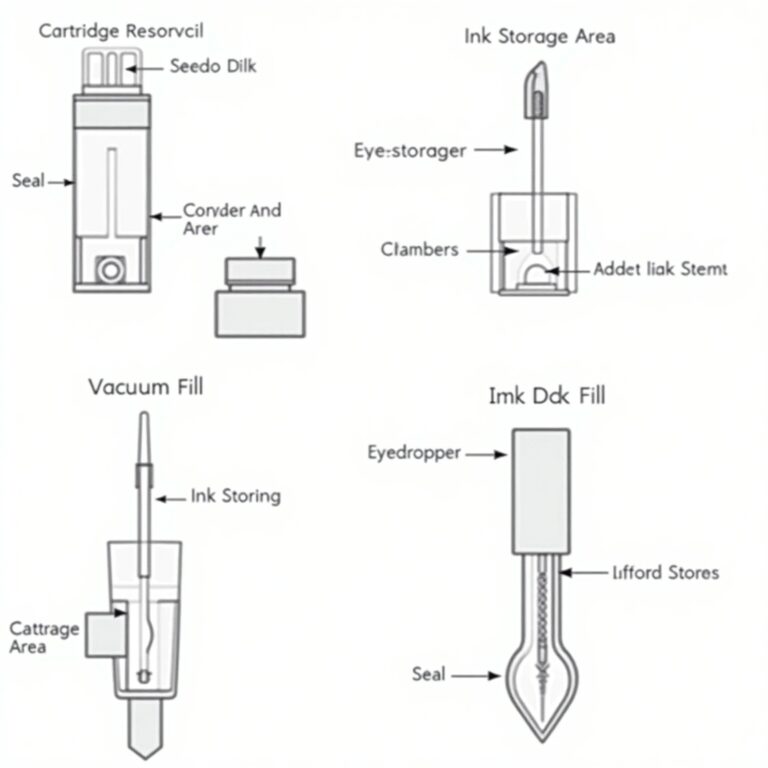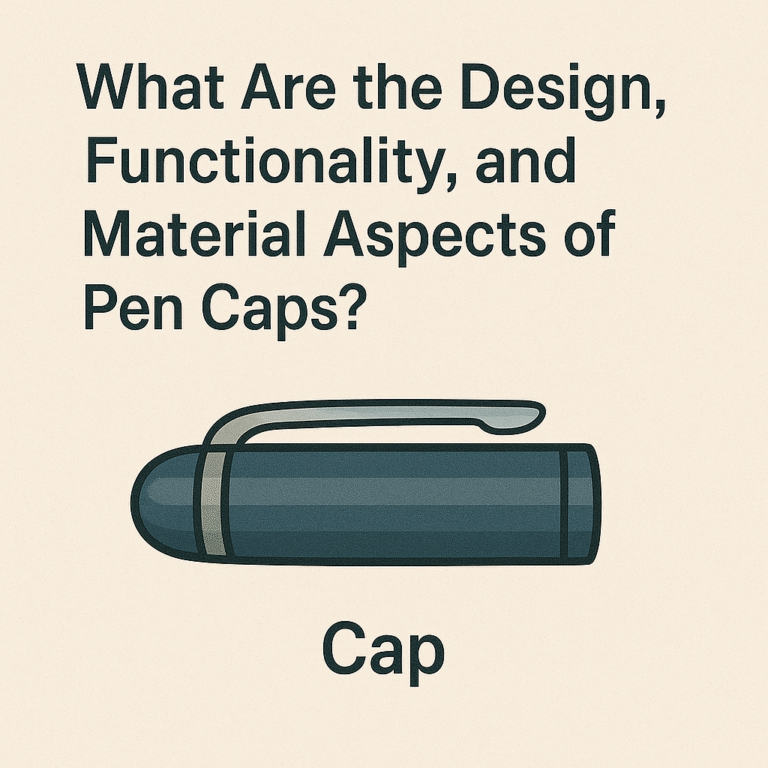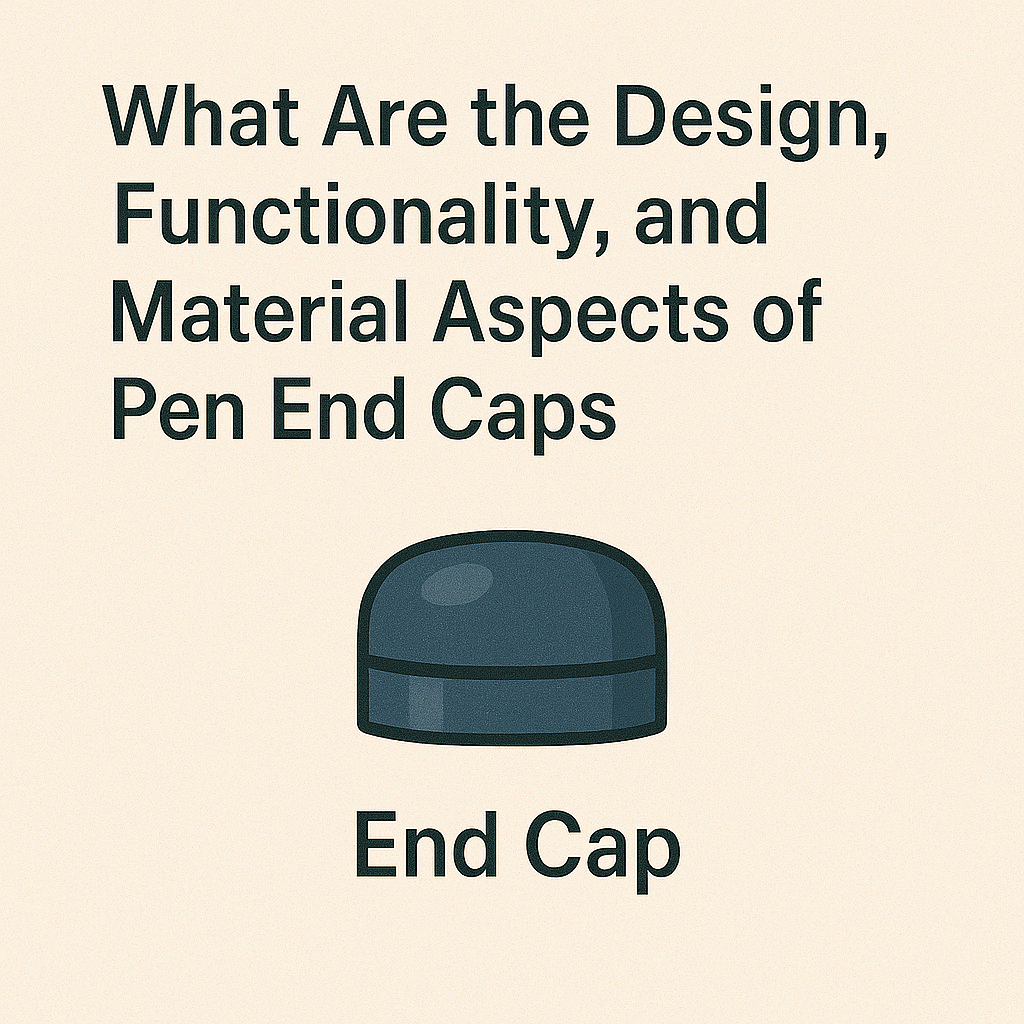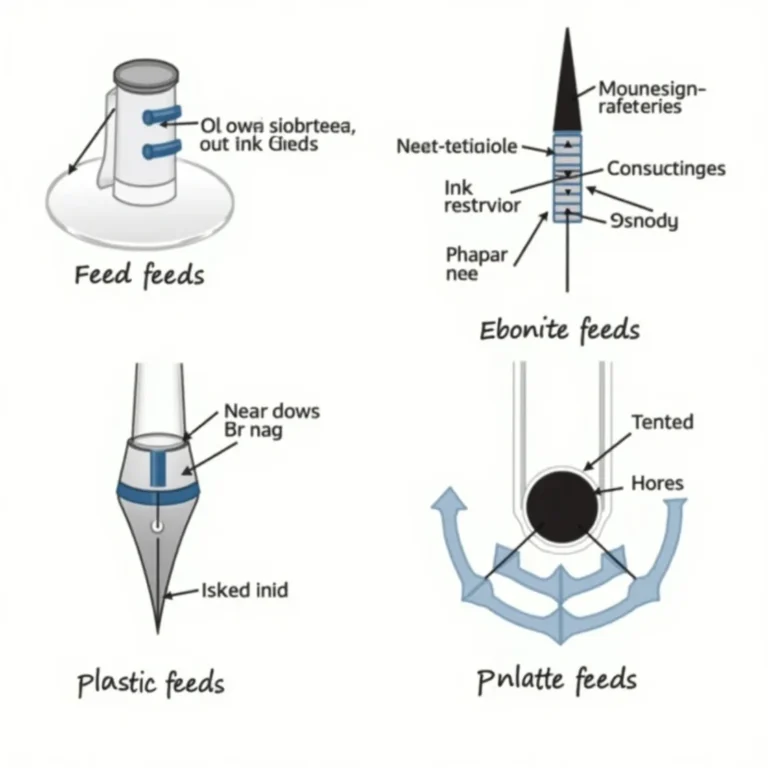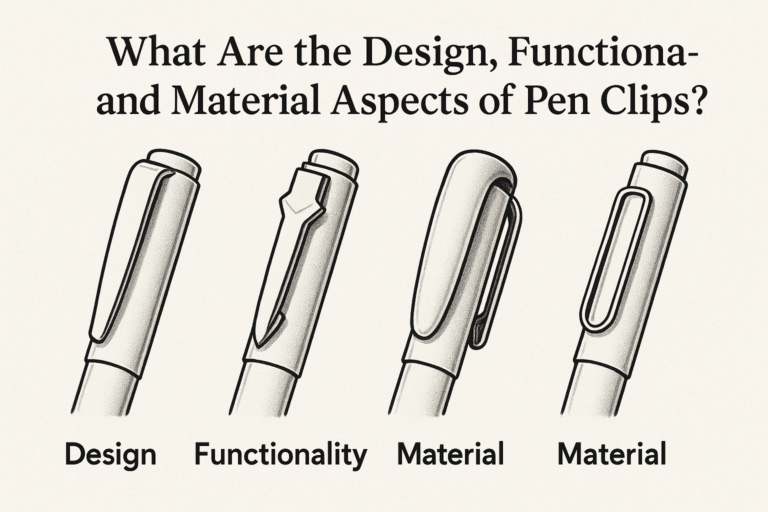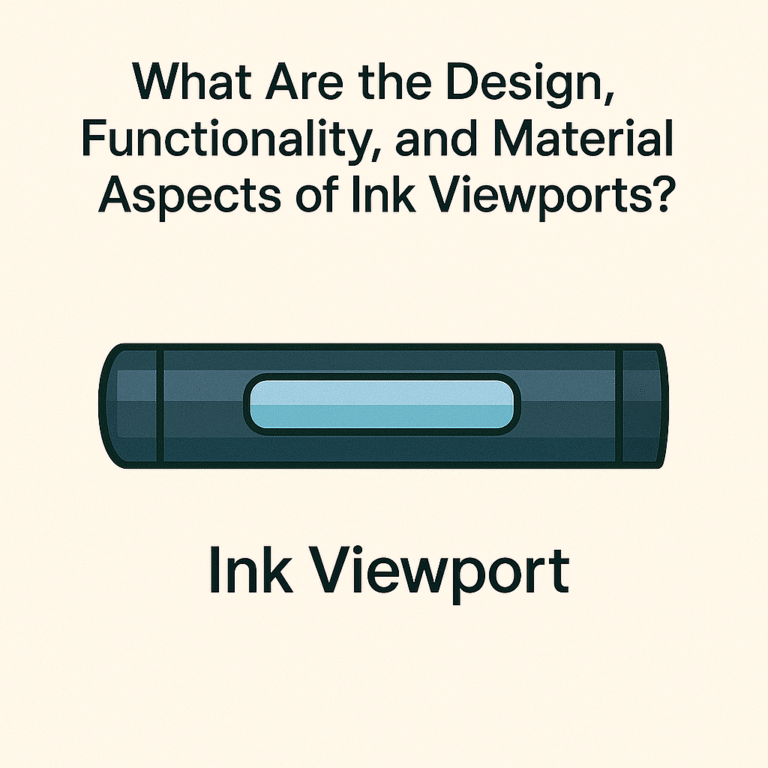What Are Pen Nib Types, Functions, And Sizes?

A pen nib is the metal tip of a pen that touches the paper and delivers ink. It controls the flow, width, and character of the lines during writing. Nibs are most commonly found in fountain pens and come in various shapes and sizes to suit different writing styles.
Pen nibs vary by type—such as fine, medium, broad, stub, italic, and flex—each offering different writing styles and stroke effects. Their function is to control ink flow and line variation on the page. Nib sizes range from extra-fine to broad, determining line thickness and writing precision. The combination of nib type and size directly affects how a pen writes and feels in the hand.
Key Takeaways
- Pen nibs vary in shape and size, like fine nibs for small text and broad ones for thick lines.
- Nibs are made from different materials; gold is flexible but costly, whereas steel is affordable and tough.
- Stub, italic, flex, and oblique nibs cater to unique writing styles.
- Knowing about nib sizes helps you choose a pen that makes your writing look the way you want.
- The right nib choice influences ink flow on paper, altering your writing or drawing style.

Overview of Pen Nibs

Pen nibs shape your writing’s look and feel, featuring a tip that meets the paper and a breather hole for ink flow control.
What is a Pen Nib?
A nib is the metal point on a fountain pen that releases ink to paper. It splits into two tines, creating a gap for ink flow by capillary action. Nibs are made from metals like steel or gold and have shapes suited for specific writing styles, such as calligraphy or detailed tasks.
They include tipping material like iridium for durability.
Wide-ranging nib types cater to different writing needs. Broad nibs produce thick lines ideal for bold expressions, while fine nibs work well for intricate writing. Some prefer stiff nibs for better control; others choose flexible ones which bend slightly with pressure to add creativity to handwriting.
Key Parts of a Pen Nib
The nib’s tip, breather hole, and shoulders are vital. The tip, made with a hard material like iridium, contacts the paper to draw lines. This design ensures smooth writing and durability.
The breather hole manages ink flow and prevents the nib from splitting under pressure. Shoulders distribute stress, supporting the tip.
Nibs come in materials such as gold, stainless steel, and titanium. Gold nibs flex easily for a smooth feel but cost more. Stainless steel offers strength at a lower price but may feel harder to write with.
Titanium combines lightness and flexibility but is pricey due to its strength and resistance to corrosion. Material choice impacts how the nib feels on paper and influences writing style.
Types of Pen Nibs
Pen nibs vary in shape and size to suit different writing and drawing needs, from broad-edge nibs for bold lines to fine pointed nibs for detailed work, including styles like italic, flex, and more. Each type enhances the user’s writing or drawing experience by matching line width, ink flow, and pressure sensitivity to their specific task.
Broad Nibs
Broad nibs make thick lines and fit well on various writing surfaces. They release more ink than fine or medium nibs, making writing bold and clear. These nibs are good for calligraphy and art, allowing for different effects with light or heavy pressure.
Artists and writers use broad nibs to make their words pop. You can find them in steel or gold for a high-quality writing experience.
Pointed Nibs
Pointed nibs are popular for their sharp tips, which create thin lines with light pressure and thicker lines with more pressure. They’re ideal for calligraphy and artistic writing, allowing for varied line widths.
Their flexibility and precision make them a favorite choice.
Different ink flows work well with these nibs, leading to smooth and diverse styles in both art detailing and elegant calligraphy. Many fountain pens feature pointed nib options, enhancing the versatility of writing experiences.
Specialty Nibs
Specialty nibs turn writing into art. They create varied stroke widths and styles. Stub nibs make thick and thin lines, depending on the pen’s angle. Italic nibs are ideal for sharp-edged fancy letters.
Flex nibs allow line width changes with more pressure during writing. Oblique nibs offer a slanted stroke, suited for specific handwriting types. Architect nibs produce fine horizontal but wider vertical strokes, favored by designers.
Music nibs feature two slits, enhancing ink flow to highlight every letter distinctly. These tools elevate writing from mere words to something special. Understanding different fountain pen types shows why the right choice is critical.
Common Fountain Pen Nib Types
Fountain pens have nibs ranging from extra fine to double broad, affecting line width and writing smoothness.
– Extra fine nibs produce tiny letters.
– Double broad nibs create thick lines.
Extra Fine (EF)
Extra Fine (EF) nibs suit small handwriting. They release less ink, which means quicker drying times. This feature is ideal for writing on thin paper without the ink bleeding through.
EF nibs produce sharp, clean lines on various papers and inks.
EF nibs are popular among artists for drawing fine details because they create very thin lines. These nibs glide smoothly across the paper when used with a light touch. Pens with EF nibs might have steel or gold tips.
Gold tips offer slight flexibility while steel ones are durable, yet both types provide good writing quality.
Fine (F)
A fine (F) nib creates thin lines, ideal for detailed and small writing. It’s great for tasks like filling out forms where clarity and quick drying are necessary. The medium (M) nib is well-suited for regular writing needs.
Medium (M)
Medium (M) nibs are a favorite for many fountain pen users. They strike a good balance for everyday writing, creating lines that are neither too thick nor too thin. This makes them ideal for quick notes and detailed letters alike.
Medium nibs perform well on various paper types with different ink colors due to their versatility. They provide strong ink flow without the need for much pressure from the user.
People pick medium nibs because they match a range of handwriting styles, adjusting easily whether you write large or small. Brands like Lamy Safari and Pilot often equip their pens with medium nibs to attract more users.
These nibs make writing in notebooks, journals, or on official papers easy and smooth.
Broad (B)
Broad nib fountain pens create wider lines than fine or medium nibs, ideal for eye-catching writing. They use more ink, producing deeper, darker lines. This is useful for writers looking to emphasize their text.
The broad nib’s thickness allows it to glide over paper smoothly, offering a comfortable experience during long writing sessions. These nibs are well-suited for calligraphy and crafting headers.
Now, let’s shift focus to double broad (BB) nibs and their characteristics.
Double Broad (BB)
Double Broad (BB) nibs are wider than most. They release more ink, creating bold and thick lines. Artists and people who prefer large handwriting often choose BB nibs. These nibs need quality paper to prevent bleeding or smearing.
Specialty Fountain Pen Nibs provide unique styles for specific tasks.
Specialty Fountain Pen Nibs
Specialty fountain pen nibs offer varied styles, from wider lines to artistic shapes.
– They influence the appearance of writing on paper.
– Unique designs like italic, oblique, and flex nibs create different line widths and ink flow.
– Nib materials such as gold or stainless steel affect writing smoothness and durability.
Stub Nibs
Stub nibs create unique writing styles. They have flat tips for thin vertical lines and thick horizontal ones. This makes them good for fancy writing easily.
Different handwriting types work well with stub nibs. Light pressure lets them move smoothly on the paper, while more pressure makes darker letters. Stub nibs vary in size, ranging from 1.1mm to 1.9mm wide tips.
Italic Nibs
Italic nibs produce lines of varying thickness. This feature makes them ideal for calligraphy, enhancing letter aesthetics. The unique shape of italic nibs allows for this variation in line width during writing.
These nibs cater to those aiming to beautify their handwriting or art projects, elevating simple writings into elegant pieces. While requiring more skill than fine or medium nibs, mastering an italic nib enriches the writing experience.
Flex Nibs
Flex nibs change line width with writing pressure. Light pressure creates thin lines; heavy pressure gives thicker ones. These nibs are ideal for stylish calligraphy. Flex nibs bend more than other types, affecting line width.
They come in gold or steel, with gold being more flexible. Learning to use a flex nib properly enhances writing style and personalization.
Oblique Nibs
Oblique nibs suit those who angle their fountain pen while writing. These slanted-tip nibs improve ink flow for angled writers. You can pick from left oblique or right oblique based on your grip.
These nibs provide a distinct writing feel, with varying line widths to match personal styles. They simplify the writing process for many users by aligning with how they hold their pens.
Architect nibs significantly benefit designers and artists, bringing versatility to drawing and lettering tasks.
Architect Nibs
Architect nibs have a unique shape for thin lines sideways and thick lines vertically, ideal for architectural drawings or specific scripts. They require skilled use due to their flat, angled tip which varies line width based on the pen’s angle.
Architects and designers prefer these nibs for precise work, making writing sharp and noticeable.
Music Nibs
Music nibs are different from architect nibs because they have three tines. This design helps them release more ink, making lines thicker and smoother. These nibs help musicians write sheet music by creating strong staff lines easily.
They can produce varied line widths with one stroke, useful for clear and bold notation. Music nibs work best on high-quality paper to prevent bleeding or smudging due to extra ink flow.
They provide a unique writing experience that blends precision with creativity.
Understanding Nib Sizes
Understanding nib sizes helps achieve the desired look and feel in writing. Wide nibs create thick lines, while narrow nibs produce thin ones, affecting your writing’s appearance significantly.
Narrow vs. Wide Lines
Fine nibs make narrow lines. Broad nibs create wide lines. Use fine nib pens for small text and details. Broad nib pens work best for large letters and bold writing. The choice affects ink usage on the paper.
Fine nibs save ink and quicken drying, ideal for note-taking and tight spaces. Broad nibs feel smoother but take longer to dry, suited for calligraphy or impactful handwriting. For detailed projects, pick a fine nib; broad ones suit creative styles better.
Nib Width Measurements
Nib sizes affect line width, from extra fine (EF) to double broad (BB). EF is like a sharp pencil, while BB resembles a marker. Brands may differ in their size definitions.
Stub and italic nibs create wider lines down and thinner ones across. Flex nibs vary in thickness with writing pressure. This knowledge helps choose the right fountain pen for specific writing styles or tasks.
Functions of Different Nib Types
Nib types affect your writing style, allowing for thick or thin lines and varying pressure. Choosing the right nib—broad, fine, flex, or calligraphy—enhances your fountain pen or calligraphy pen experience by adjusting line width, ink flow, and smoothness on paper.
Writing Styles and Applications
Different nibs support various writing styles. A broad nib creates bold, thick lines that catch the eye. Fine and extra fine nibs are perfect for small, detailed work, allowing many words on a page without clutter.
For calligraphy, italic and stub nibs produce wide vertical strokes and thin horizontal lines, giving letters an artistic flair. Flex nibs change line width with writing pressure, adding personality to handwriting or art.
Each fountain pen nib has its use: medium nibs for everyday note-taking; music or architect nibs add decorative touches to writing.
Line Variation and Flexibility
Nib types and writing pressure change line width. Flex nibs offer more variation with pressure than stiff ones. A gentle press produces thin lines, while heavy pressing results in wider lines.
This feature is crucial for calligraphy and artistic purposes.
Choosing between nib sizes like fine or broad impacts line variation too. Fine nibs create precise, narrow lines suitable for small text. Broad nibs make thick, bold lines ideal for headlines or decorative writing.
Pen users pick based on their personal style and needs.
Conclusion
Pen nibs vary in shape and size, meeting different writing needs. Some create fine lines; others draw thick marks. Common sizes include fine, medium, and broad for daily use, while stub or calligraphy nibs cater to unique styles.
Each type influences ink flow and appearance on the page.
Materials like gold and steel are typical for nibs. Gold bends easily, offering line flexibility. Steel is tougher and more durable.
Choosing the correct pen nib enhances your writing or drawing. With a wide range available, finding one that matches your style is easy.
FAQs
1. What are the different types of pen nibs?
There are many types of pen nibs, including broad nib, fine nib, medium nib, stub nib, italic nib and more. Other unique ones include zoom nib and music nib.
2. How does the size of a fountain pen’s gold or steel nib affect writing?
The size of a fountain pen’s gold or steel nib impacts line width and ink flow. A larger sized broad or round-nib can give wider lines while a smaller fine or extra-fine one gives narrower lines.
3. Can the material used in making the pen tip influence my writing experience?
Yes! The tipping material like rhodium plating on stainless steel or titanium affects your writing smoothness as well as corrosion resistance.
4. Does the function of each type of fountain pen’s flexible and stiff nubs differ?
Absolutely! Flexible nubs like flex and fude allow for varied line widths based on pressure applied during writing which is great for calligraphy pens; while stiff ones such as hooded give consistent lines suitable for everyday use.
5. Is there any difference between left-handed and oblique dip pens’ quill tips?
Indeed! Oblique dip pens have slanted tips that help right-handers with certain scripts while left-handed quills specifically cater to their needs ensuring proper capillary action for ink flow at optimal angles.
6. How do I know which type of Japanese ballpoint pen’s titanium or platinum group tipped-nib suits me best?
It depends on your preference in terms of writing angle, surface you’re working on, desired line width from broad-edge to reverse oblique options; even characteristics like carat rating matter when considering longevity against corrosive effects.
